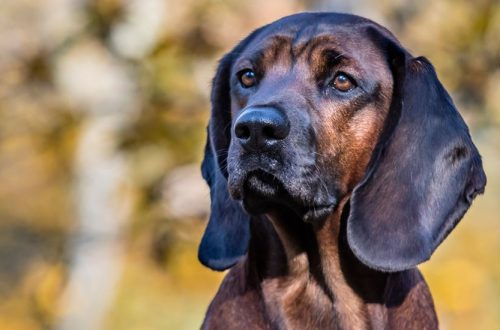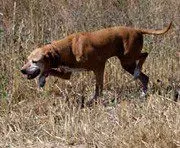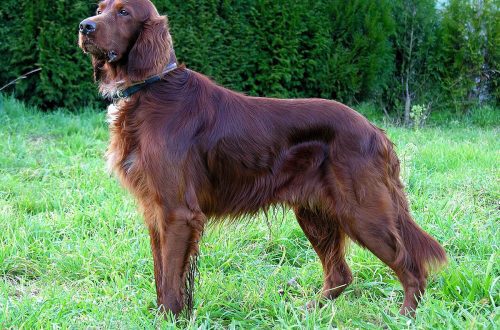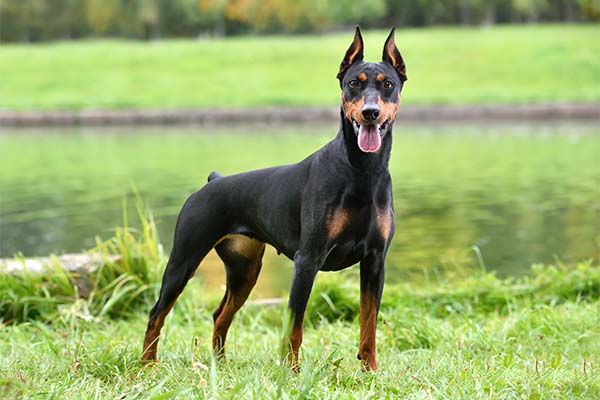
German Pinscher
Other names: standard pinscher
The German Pinscher is a rare breed of black and tan and reddish brown dogs that have been bred in Germany since the 18th century. The most famous descendants of Pinschers are Rottweilers, Dobermans, Affenpinschers and Miniature Pinschers.
Contents
- Characteristics of German Pinscher
- Basic moments
- History of the German Pinscher breed
- Video: German Pinscher
- German Pinscher Standard
- Character of the German Pinscher
- Education and training the German Pinscher
- Maintenance and care
- Health and disease of German Pinschers
- How to choose a puppy
- German pinscher price
Characteristics of German Pinscher
| Country of origin | Germany |
| The size | average |
| Growth | 45–50 cm |
| Weight | 11.5-16 kg |
| Age | 15–17 years old |
| FCI breed group | pinschers and schnauzers, molossians, mountain and swiss cattle dogs |
Basic moments
- Standard Pinschers have a reputation as rare pets both in their homeland and in the world. According to the Pinscher-Schnauzer Club of Germany, about 400 purebred representatives of this family are registered per year.
- German Pinschers are capable of doing any kind of sports with the exception of weight pulling, but you should not expect great achievements from them in sports disciplines.
- Standard Pinschers are quite friendly with other pets and easily relate to the appearance of a second “tail” in the dwelling. However, friction can arise with cats due to the constant attempts of the dog to draw the purr into his games.
- A characteristic feature of the breed is the desire to independently “steer” the owner’s life and the surrounding reality in general. Having a Pinscher puppy at home, get ready to seriously invest in the educational process so as not to be run errands by the animal.
- Standard Pinschers do not belong to the category of overly talkative dogs, so owners and others are not annoyed by unreasonable barking.
- The breed is recommended for keeping active people who are ready to build their own daily routine, taking into account long walks of the dog, as well as games with it.
- Responsible watchmen are obtained from German pinschers, who do not let a single living soul into the house without informing the owner of its arrival in advance.
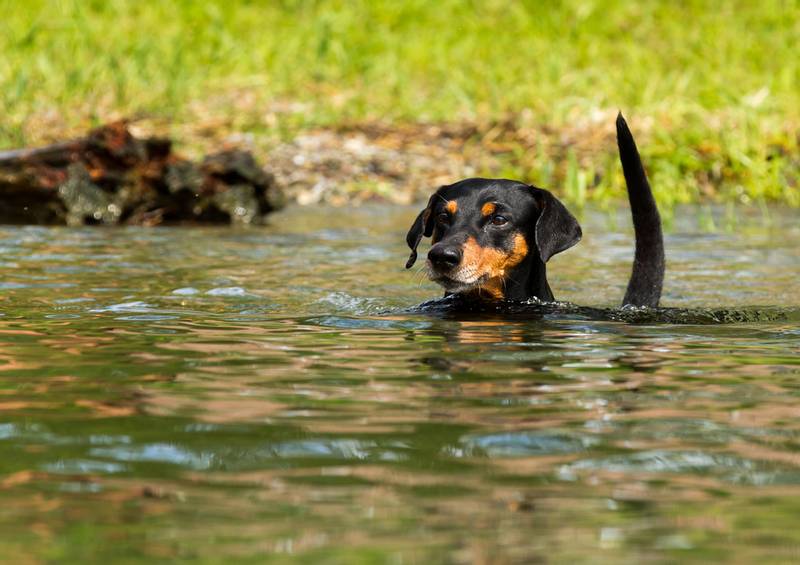
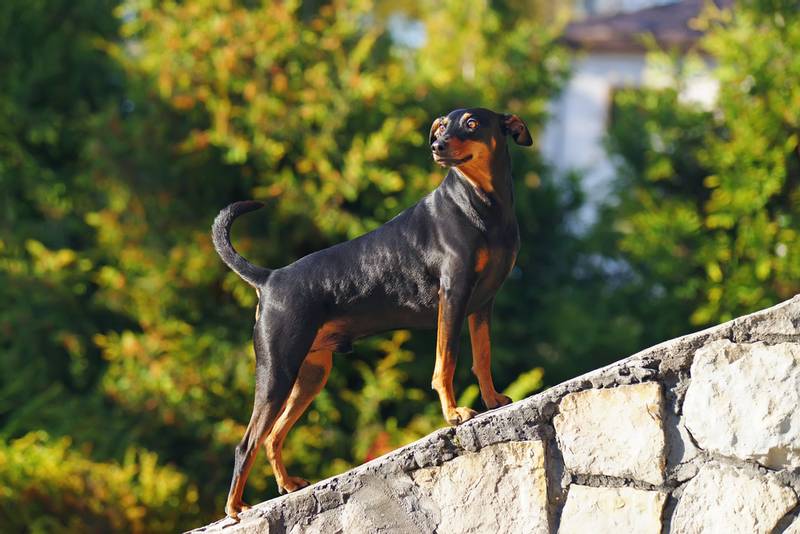
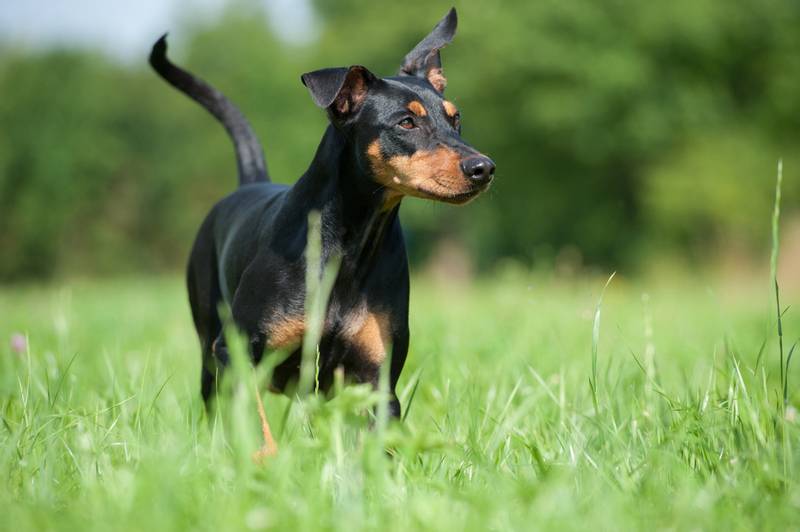
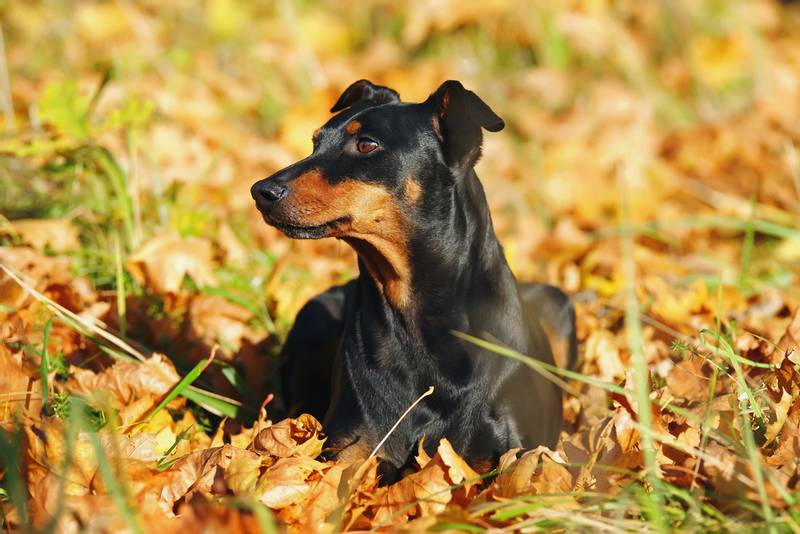
German Pinscher – a thunderstorm of small rodents and a quick-witted rogue, with proper training, transforming into a perky and humorous companion. Among breeders, this savvy merry fellow enjoys a reputation as an adventurer and “chameleon”, so take a closer look at the breed if you need a dog that can save you from blues and boredom. And of course, give up hope of lying on the couch with a pinscher under the “grunts” of your favorite TV show – this is not the kind of pet that is crazy about lounging and constantly sitting within four walls.
History of the German Pinscher breed
German Pinschers are not the most ancient breed, but there is still no reliable information about its origin. It is assumed that the progenitors of animals could be swamp dogs, which were considered good rat-catchers and lived in Western Europe from time immemorial. But since this hypothesis has not been documented, one can endlessly guess about the real ancestors of pinschers.
The first written mention of the breed dates back to 1836. Then the standard pinschers were bred not throughout Germany, but mainly in the vicinity of Württemberg. At first, the animals were kept by burghers overcome by rodents. Nimble and quick-witted dogs quickly destroyed mice, thereby saving the food supplies of the townspeople. Later, the Germans began to acquire inquisitive dogs and just for fun. By the way, it was the German Pinschers that brought to naught the fashion for pugs that had been in Germany for more than a century.
Gradually, the breed expanded its field of activity and began to travel with coachmen. Suddenly it turned out that the German Pinschers are quite hardy and are able to run for several kilometers without falling from fatigue. In the realities of that time, such pets were extremely profitable. For example, in the absence of a charioteer, the dog was placed inside the stagecoach without any problems and scared off thieves with a loud bark, and when the vehicle was full of passengers, it could easily run behind the carriage. In addition, four-legged watchmen continued to hunt rodents in horse stalls and barns, for which they were nicknamed stable pinschers and ratlers (from German Ratte – a rat).
Until 1879, German Pinschers were bred together with Schnauzers , which made it possible to obtain smooth and wire-haired puppies in one litter. Later, the animals stopped knitting with each other, which was the first step towards making pinschers into an independent pedigree branch. In 1884, a separate appearance standard was drawn up for the descendants of marsh dogs, which was revised twice – in 1895 and 1923. According to the first standard descriptions, pinschers could have any color – the restriction on color types was introduced much later.
In the 40s of the XX century, interest in the breed faded, and in the 50s, pinchers almost ceased to be bred. The director of the German Pinscher-Schnauzer Club, Carl Jung, undertook to restore the livestock, through the efforts of which the number of purebred individuals in Germany was increased several times. In 1989, the breeder Burkhard Foss decided to update the phenotype of the standard pinscher for the last time and for ten years in a row he bred his males with a Doberman bitch named Evie. According to experts, the Foss experiment benefited not only the exterior, but also the psyche of the resulting offspring, making it more stable.
Video: German Pinscher
German Pinscher Standard
Judging solely by dimensions, we can say that a standard pinscher is an intermediate link between a doberman and a miniature pinscher . Smooth-haired, compact, but far from pocket-sized, the dog looks like a muscular, strong man, ready to immediately rush in search of adventure. The growth of the average representative of the breed is 45-50 cm; weight – 14-20 kg, and these parameters are equally relevant for both males and females.
Head
The skull with smoothed lines of the forehead and occiput is slightly elongated in length. The transition from the head to the muzzle is barely pronounced, but noticeable. The muzzle forms a blunt wedge with a flat bridge of the nose.
Jaws, lips, teeth
The lips of the German Pinscher are dry, black in color, completely hiding the corners of the mouth and tightly bordering the jaw area. Number of teeth – 42. Jaws of a dog of moderate strength, in the bow forming a “full scissors” bite.
German Pinscher Nose
Rather large, but harmoniously developed lobe is painted in a rich black tone.
Eyes
Almond-shaped eyes should have the darkest iris possible and be well covered by dense black skin of the eyelids.
Ears
The ear cloth is V-shaped, high landing, hanging down on elastic cartilaginous tissue. The back edges of the ears are turned towards the temples and touch the zygomatic zone. An important feature: the areas of the ear folds should not rise above the cranium.
Neck
Due to the elegant curve, the dry neck of the dog looks elegant and sophisticated. The skin fits snugly to the throat area, so the presence of dewlaps and dewlaps is not typical for the breed.
Frame
In the reference German Pinscher, the outlines of the body gravitate towards a square type. The topline, starting from the withers, goes under a slight slope. The back is strong, well stretched, with a deep shortened loin, which enhances the compact appearance. A slightly rounded croup smoothly passes into the root of the tail; broad chest, oval in cross section, lowered almost to the elbows. The inguinal regions of the standard Pinscher are barely tucked up and form a gentle curve with the lower abdomen.
German Pinscher limbs
The forelimbs are even, with adjacent muscular shoulder blades set extremely obliquely. Straight forearms are pronounced and evenly muscled. The pasterns are springy, slightly inclined when viewed from the sides.
For the hind legs of the “German” a parallel, but not excessively narrow set is typical. Moreover, when assessed from the sides, the hind limbs are located in relation to the body at a slight inclination. The hips of the dog with well-developed muscles, of impressive length and width. The knees, as well as the elbows of the front legs, without eversion to the outside and inside. The sinewy lower legs pass into strong hocks, ending in vertical metatarsus.
The paws are rounded, with arched toes gathering into a ball, dense pads and black claws. An important nuance: the hind legs are always slightly longer than the front ones. The German Pinscher moves in a free trot. The length of the step in motion is formed by the free reach of the front and a powerful push of the hind limbs.
German Pinscher Tail
A harmoniously developed tail should have a natural appearance. According to the German law of 1998, docking of this part of the body and ears of the German Pinscher is officially prohibited.
Wool
The coat is very short, dense, evenly covering the body of the dog. Healthy hair has a pleasant satin sheen, which is especially noticeable in the sun or in well-lit rooms.
Color
The standard recognizes the single color (red-brown, murugo-red) and black and tan colors of the breed. Ideally, if the tan marks are extremely saturated in color and distinct in shape. Tan spots are distributed in this way: under the tail, on the inside of the hind limbs, on the metacarpus and paws, in the throat area, above the inner corners of the eyes.
Disqualifying vices
German Pinschers will be disqualified for the following faults:
- any malocclusion;
- inconsistency with the sexual type (females resembling males, and males in the type of females);
- deviations from the growth specified by the standard by more than 3 cm;
- nervousness, distrust, cowardice and uncontrolled aggressive behavior;
- defects in the constitution, color and type of wool, which make it possible to suspect the impureness of the individual.
Character of the German Pinscher
The German Pinscher is a personality dog. Moreover, the personality is cunning, impossibly curious, able to benefit from the most seemingly ordinary situations. At home, a smart scoundrel tries to adapt to the owner, but at the same time he will never agree to the role of a secondary pet. Moreover, with the rest of the four-legged creatures, the pinscher is able to get along and even be friends, but this does not bother him at all to consider himself head and shoulders above the rest of the “tails” in the house. Testing the authority of the owner for strength is another favorite pastime of young individuals, so do not succumb to provocations. As soon as the dog feels that the leader’s throne has been vacated for a moment, he will immediately reign on it.
German Pinschers are champions in their ability to dodge, cunning and portray universal remorse. These abilities are especially pronounced when a scolding threatens. Usually, a dog that has been at fault has two tactics of behavior: diverting a person’s attention by calling for games or pulling a mournful, guilty mine on its face, looking at which the animal wants to hug and regret, but not punish in any way. If for some reason they shouted at the pinscher or denied him what he really wanted, he will not be offended, but will quickly adapt to the situation. For example, once again he will pretend to be an understanding good boy who has realized his own wrong, or he will try to get by cunning what he had his eye on earlier. Only one thing is absolutely certain – the “German” will not sulk and show aggression, because it is simply unprofitable.
A little about the antics of standard pinchers. The breed, like the Duracell bunnies, is able to be active indefinitely. For this reason, the dog is constantly trying to draw the owner into the game. If the owner refuses to satisfy the entertainment needs of the pet, he will not insist and will occupy himself. However, keep in mind that sometimes such “self-entertainment” ends with re-pasting wallpaper, painting over scratches and hauling home furniture. Accordingly, if you are not ready for destructive surprises, educate the ward correctly and do not leave unattended for a long time.
The hunting instinct of the breed is muted, but this does not prevent the German Pinscher from getting into various adventures on the street. In addition, sometimes the spirit of the ancestors wakes up in the pet, demanding a small sacrifice, which is usually mice and garbage rats. On walks, the descendants of wading dogs seek adventure wherever possible. If nothing interesting came into view, the dog will try to compensate for the lack of impressions by wallowing in something smelly. And the stronger and more disgusting the smell of the substance, the more pleasant it is for the pinscher.
The breed merges surprisingly easily into dog groups, occupying the niche of an entertainer in them. So if you are afraid for the health of a pet that has run away to get acquainted with shepherd dogs resting in the distance, then it is completely in vain – German pinschers are not satisfied with fights with fellow tribesmen. Well, if a real danger suddenly loomed on the horizon, then the savvy “Germans” would prefer not to run into them here either and would rush off at such a speed that the fastest Greyhound would envy .
Education and training the German Pinscher
Due to the natural tendency to manipulate and the ability to adapt any situation to one’s own needs, there are no “servants” from the German Pinscher. But this does not mean that the breed cannot be trained. On the contrary, pinschers are ultra-smart, have a developed intuition, and in terms of intelligence they are not inferior to such Einsteins of the canine world as poodles and border collies . The problem of raising and training the breed lies only in the fact that its representatives are engaged exclusively in their mood and work disgustingly under duress.
Experienced dog handlers say that the first and most important lesson for a puppy who has moved to a new home is the need to follow the restrictions set by man. That is, in addition to recognizing the authority of the owner, the German Pinscher is obliged to obey the internal routine of the family and not violate the prohibitions known to him. It is important not to go too far and not try to drill the dog. Relatives of Dobermans will not endure hard pressure.
In order to raise an exemplary companion and pet from a standard pinscher, experienced breeders recommend stocking up on perseverance and the ability to treat the animal’s tricks with humor. Remember, the breed tends to bypass restrictions, but not explicitly, but on the sly. For example, a dog will endure the temptation of a bowl of cat treats in front of a human, but will empty the bowl the first few seconds the cat leaves the room. Trying to scold and punish the German Pinscher for being enterprising is pointless. First, he managed to put his misdeed out of his mind at the very moment when the bowl ran out of delicacies. And secondly, at the very first notation, the dog will portray such repentance that you will be ashamed of your own reproaches. Reprimand the dog when you definitely catch it in the act and don’t make a tragedy out of it.
An important nuance when working with a pinscher is that it is important not to get hung up on the impeccability of fulfilling the requirements. For most pets, for normal integration into the family and the street environment, it is enough to complete the UGS course, which includes basic dog management commands. Often, videos are posted on breed forums in which standard pinschers demonstrate a brilliant command of OKD. Indeed, it is not difficult for the breed to cope with such courses – it will be difficult for the owner who decides to discipline the pet like a service dog. Therefore, when you see a pinscher passing obedience standards, keep in mind that months of titanic work of a cynologist stand behind the animal’s honed actions.
German Pinschers are trained according to the same principle as all cunning dogs – trying to interest the process, affection or delicacy. To concentrate the attention of the animal, European breeders recommend using a clicker. If you can’t manage a four-legged rogue even after reading mountains of special literature and watching dozens of training videos, it’s better to entrust the matter to professionals. For example, from the age of three months, it is useful to take puppies to training grounds, where instructors conduct a course of educational training. A more effective option is individual paid classes with a cynologist, after which you will receive a pet that is manageable and more or less understanding of commands.
Maintenance and care
The ancestors of the German Pinscher lived in carriage sheds and barns, but modern representatives of the breed are 100% apartment and pets. Of course, the dog is not averse to spending time in the yard or on the site of a country house, but only in the summer and during the day. Daily walks for the breed is an urgent need, and you need to take its representatives out to “ventilate” twice a day, for at least an hour and a half.
Always remember that German Pinschers are weather dependent dogs. For example, most individuals categorically refuse to walk if mushroom rain is drizzling outside the window. You can try to solve the problem by buying waterproof blankets, but, according to experienced breeders, it is often impossible to impress a four-legged prankster even with such attributes of comfort. In frosty weather, it is better to reduce the duration of walks if your ward is not a fan of sports exercises and active games, or buy a warm overalls for the dog in which he definitely will not catch a cold.
Hygiene
As with all short-haired breeds, German Pinschers do not have to spend money on grooming, learn the basics of proper stripping, or run around the apartment with a vacuum cleaner to collect loose pet hair. All it takes to maintain the beauty of the coat is stroking it with a rubber mitten or brush a couple of times a week to collect dead hairs.
The issue of bathing, if you do not have a show animal, is even easier to solve. Pinschers are supposed to be washed as they get dirty, which happens more often than we would like, due to the love of dogs for wallowing in carrion and excrement. In summer, hygiene procedures can be carried out in natural reservoirs, but keep in mind that the breed does not burn with desire to swim and bathe, so if it climbs into the water, it is only to please the owner.
The hygiene of the ears of the German Pinscher should be carried out once a week. If the examination reveals an excess of wax, drop a hygienic lotion such as Veda or Favorite into the funnel, massage the folded ear for a few minutes, and allow the animal to shake its head so that the remaining liquid flows out along with the impurities. In addition, it is necessary to ventilate the pet’s ears daily, holding them by the tips and waving lightly to help the air enter the funnel. Another option is to wrap the ear cloth back, gently fixing it with special clothespins.
If ventilation is not done, the humidity inside the ear increases, pathogenic bacteria develop in it, causing itching. As a result, trying to get rid of unpleasant sensations, the German Pinscher shakes its ears, “breaking” thin sensitive tips into the blood. As an alternative to “airing” the hearing organs, cupping can be considered. But it is worth carrying out the procedure only if you have a pet – in Germany and other European countries, docking is prohibited and individuals with “shortened” ears are not allowed to international exhibitions.
The eyes of German Pinschers are relatively healthy, so it is recommended to simply examine them, removing mucous lumps from the corners with a clean cloth moistened with hygienic lotions based on chamomile broth. If there is discharge from the eyes, go to the veterinarian – in healthy representatives of the breed, the eyes do not flow. Pinscher claws are shortened once a month.
German Pinscher Feeding
On breed forums, German Pinschers are called “vacuum cleaners” for their constant passion for snacking and the habit of dragging any food that is not lying well. For this reason, talking about types of feeding is not entirely appropriate. Any pinscher that eats industrial “drying” steals tomatoes and sausage from time to time, and vice versa – individuals sitting on natural food, no, no, and they will take away its “Proplan” from the cat.
If you describe the pet’s menu in terms of health benefits, then we can say that the diet of the German Pinscher is no different from the diet of any domestic dog. The basis of the animal’s nutrition is lean sinewy meat, which, in order to save money, is periodically replaced with offal and fish fillets (only frozen sea fish). With meat waste, you can also cook buckwheat and rice porridge.
A dog can get the missing vitamins from vegetables (carrots, beets, pumpkin crops), fruits (apples, bananas, pears, occasionally plums), berries (blueberries, gooseberries). Low-fat dairy products and chicken eggs should also appear regularly in the pinscher bowl, as should fresh herbs in the form of celery and parsley. And of course, do not forget about vitamin and mineral supplements, which are mandatory for all dogs that eat natural food.
For those who have chosen ready-made dry food for their four-legged pet, it is better to prefer well-known brands of super-premium and above. They are more nutritious, do not contain harmful cheap ingredients and are enriched with vitamins and microelements necessary for the Pinscher. Most likely, you won’t have to choose a brand according to the dog’s taste preferences – the “Germans” blizzard everything in a row, not forgetting to beg for an additive.
Health and disease of German Pinschers
Standard Pinschers have very strong immunity, but a genetic predisposition to a number of ailments is not excluded, including von Willebrand disease, hereditary cataracts, heart diseases (mitral valve dysplasia, heart disease, subaortic stenosis). In almost half of puppies and teenagers, the tips of the ears are injured when the animal shakes its head. This phenomenon is due to the fact that the skin on the outer part of the ear dries out and becomes more vulnerable (superficial ear vasculitis). To prevent wounds from appearing in the future, you need to monitor the hygiene of the ear funnel (clean, ventilate), and also lubricate the dry skin of the tips with nourishing cream or coconut oil.
How to choose a puppy

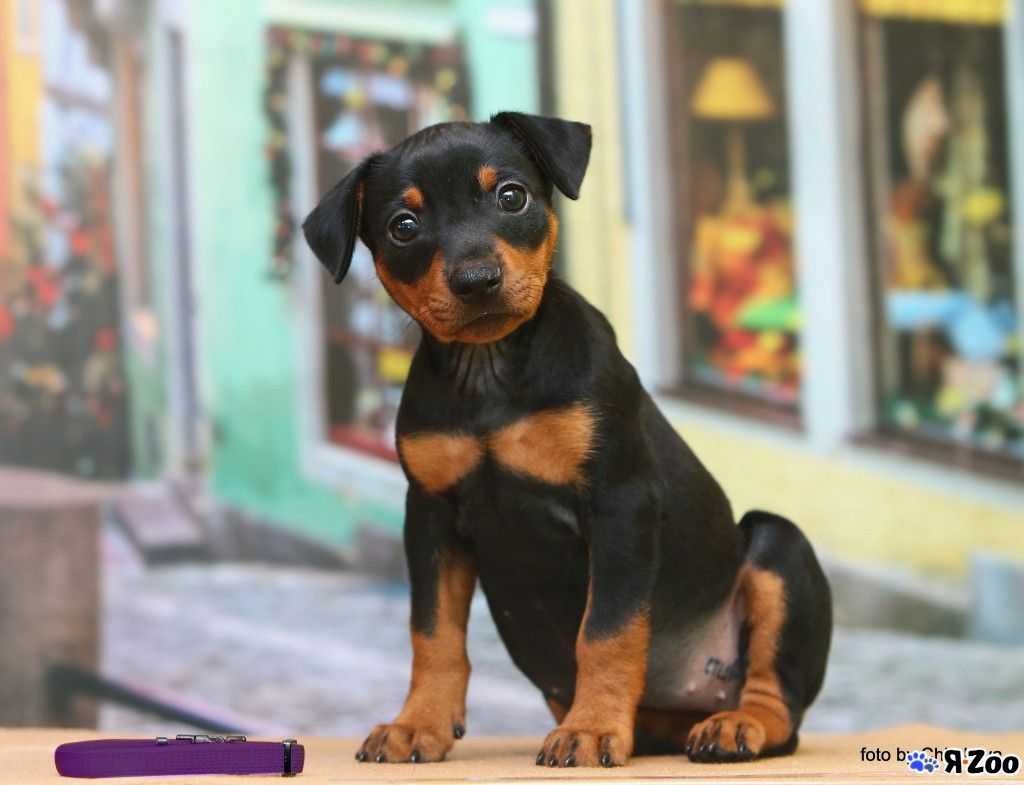
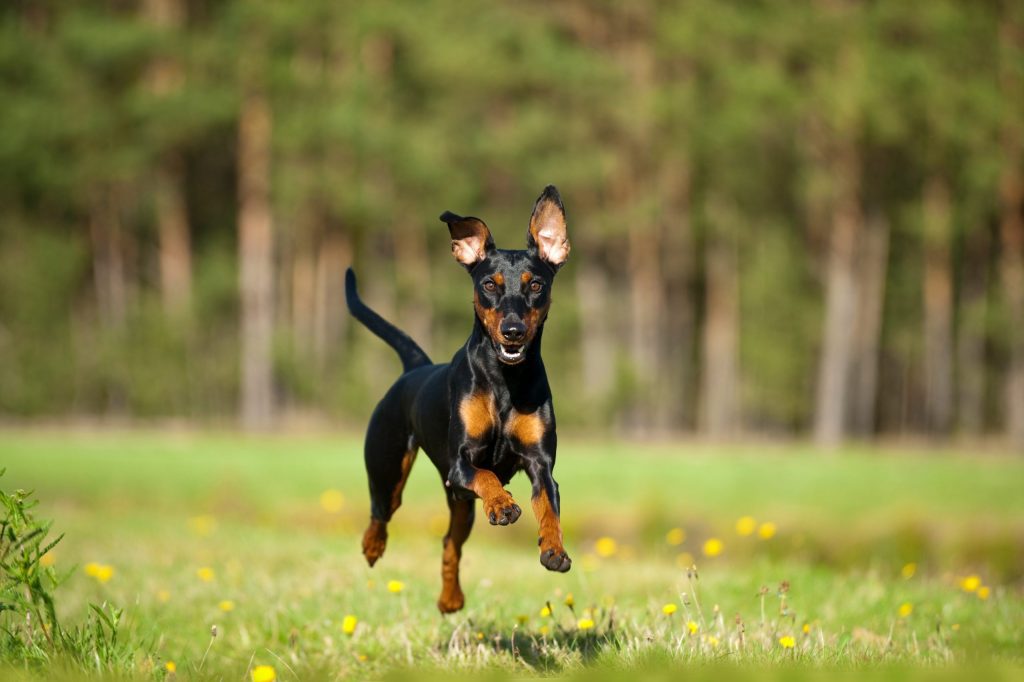
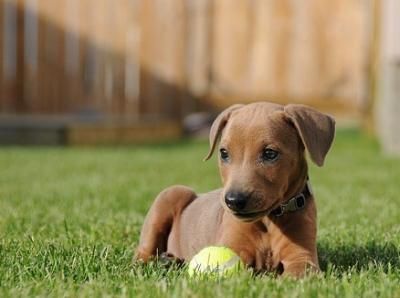
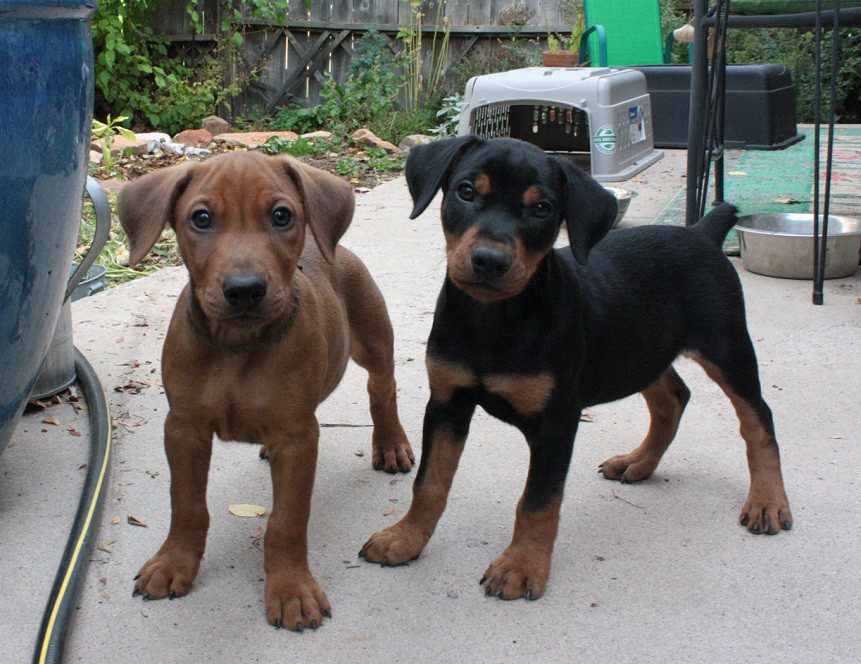
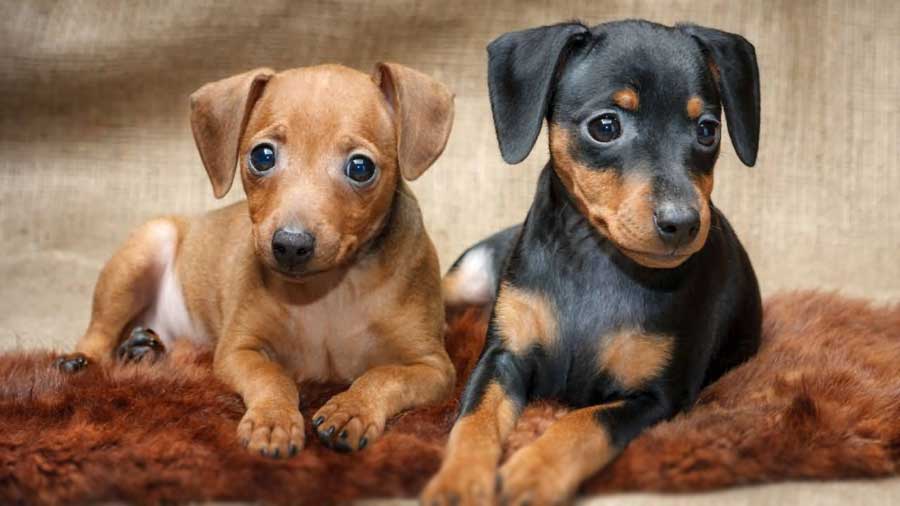
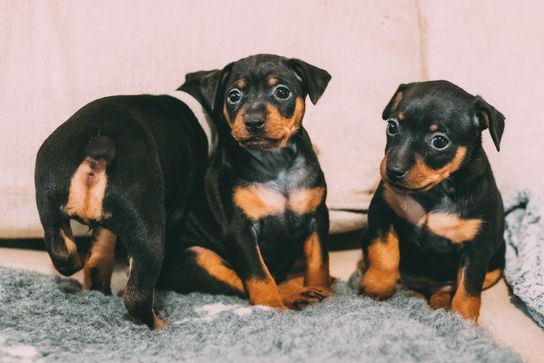
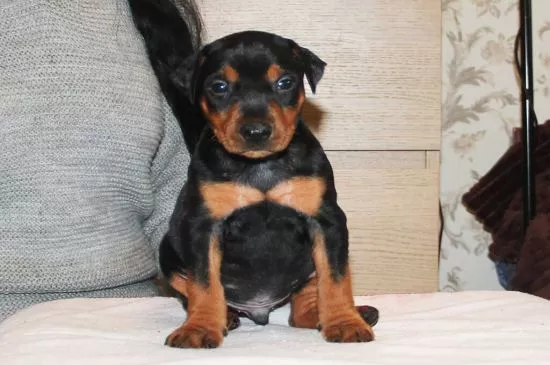
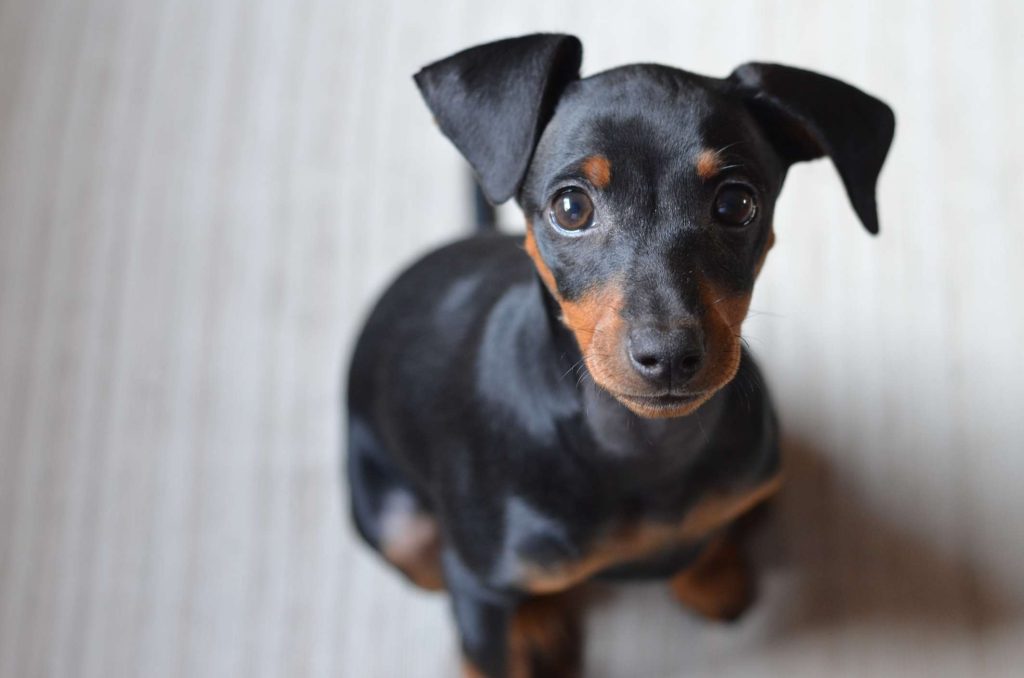
- If the breeder does not save on testing producers for genetic diseases and willingly shows the results of the examination, this is a good sign.
- Carefully study the pedigree of the litter, find out if the German Pinscher puppies are dewormed, if they have been vaccinated appropriate for their age.
- Choose a bold, curious puppy and immediately dismiss the insecure and aggressive kids who, having matured, will create a lot of problems with their behavior.
- Find out what breed type a particular breeder offers. There are German Pinschers in the Schnauzer type and in the Dobermann type . The former have a more powerful physique, the latter are more graceful and higher on their feet.
- Check with the seller from which countries the breeding female and male originate. In addition to German sires, offspring of standard pinschers from Finnish and Swedish lines are valued.
- If a puppy is bought for show or as a future breeding individual, it is important that his ancestors are tested for the so-called color weakness. If this gene appears in offspring, the path to the ring and breeding will be closed.
German pinscher price
If you want to buy a dog of German blood, then it is better to look for professional breeders who breed and sell puppies in Germany on special sites like vdh.de. As for prices, in the homeland of the breed they start from 900-1000 euros. By the way, if you plan to buy a foreign pinscher for subsequent breeding, you will have to work hard – they do not like to sell producers abroad in any of the European countries. There are also several kennels in Russia where you can take a healthy dog with RKF metrics. The cost of such a German pinscher will range from 700 to 900$.



